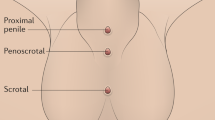Abstract
Hypospadiology is a rapidly evolving field. Progress in the understanding of how hormonal therapy affects the growth of the phallus has allowed surgeons to optimize the tissues for surgery. But conflicting data from a number of studies and a lack of consensus on drugs, their dosing, mode of delivery and timing of use means that the creation of protocols is unlikely to happen in the near future. Nonetheless, there is a hope and the standardization of scientific reporting will make it easier to compare data at the global level. There are reports of the increasing incidence of hypospadias and the etiology is thought to be multifactorial. Although complex interactions between genetic polymorphisms and the environment make it difficult to identify the exact factors responsible for hypospadias, the advent of massively parallel gene sequencing, large scale epigenetic screens and CRISPR technology will definitely ease the process. The knowledge of culprit genes will not only broaden our understanding of embryology and growth but will also enable us to predict and/or modify tissue healing. Advances in tissue engineering are also expected to provide a plethora of biomaterials for urethral reconstruction. The development of this field is directly linked with the elucidation of the processes of proliferation and vascularization coupled with the cataloguing of the growth factors involved. One can safely conclude that the exciting new advances in the field will have far reaching consequences on patient care and counselling.
Similar content being viewed by others
References
Baskin LS, Himes K, Colborn T. Hypospadias and endocrine disruption: is there a connection? Environ Health Perspect. 2001;109:1175–83.
Albers N, Ulrichs C, Glüer S, et al. Etiologic classification of severe hypospadias: implications for prognosis and management. J Pediatr. 1997;131:386–92.
Gilliver SC, Ashworth JJ, Ashcroft GS. The hormonal regulation of cutaneous wound healing. Clin Dermatol. 2007;25:56–62.
Netto JMB, Ferrarez CEPF, Schindler Leal AA, Tucci S, Gomes CA, Barroso U. Hormone therapy in hypospadias surgery: a systematic review. J Pediatr Urol. 2013;9:971–9.
Koff SA, Jayanthi VR. Preoperative treatment with human chorionic gonadotropin in infancy decreases the severity of proximal hypospadias and chordee. J Urol. 1999;162:1435–9.
Bastos AN, Oliveira LRS, Ferrarez CEPF, de Figueiredo AA, Favorito LA, Bastos Netto JM. Structural study of prepuce in hypospadias--does topical treatment with testosterone produce alterations in prepuce vascularization? J Urol. 2011;185:2474–8.
Gorduza DB, Gay C-L, de Mattos E, et al. Does androgen stimulation prior to hypospadias surgery increase the rate of healing complications? - a preliminary report. J Pediatr Urol. 2011;7:158–61.
Göllü Bahadır G, Ergün E, Telli O, Khanmammadov F, Çakmak AM. Hormone therapy in hypospadias surgery: a survey on the current practice in Turkey. Turk J Med Sci. 2016;46:1624–8.
Ratan SK, Aggarwal SK, Mishra TK, et al. Hormonal profile in children with isolated hypospadias associates better with comprehensive score of local anatomical factors as compared to meatal location or degree of chordee. Indian J Endocrinol Metab. 2014;18:558–64.
Snodgrass WT, Villanueva C, Granberg C, Bush NC. Objective use of testosterone reveals androgen insensitivity in patients with proximal hypospadias. J Pediatr Urol. 2014;10:118–22.
Chalapathi G, Rao KLN, Chowdhary SK, Narasimhan KL, Samujh R, Mahajan JK. Testosterone therapy in microphallic hypospadias: topical or parenteral? J Pediatr Surg. 2003;38:221–3.
Bouty A, Ayers KL, Pask A, Heloury Y, Sinclair AH. The genetic and environmental factors underlying hypospadias. Sex Dev. 2015;9:239–59.
Marrocco G, Grammatico P, Vallasciani S, et al. Environmental, parental and gestational factors that influence the occurrence of hypospadias in male patients. J Pediatr Urol. 2015;11:12–9.
Haraguchi R, Mo R, Hui C, et al. Unique functions of Sonic hedgehog signaling during external genitalia development. Dev Camb Engl. 2001;128:4241–50.
Klonisch T, Fowler PA, Hombach-Klonisch S. Molecular and genetic regulation of testis descent and external genitalia development. Dev Biol. 2004;270:1–18.
el-Galley RE, Smith E, Cohen C, Petros JA, Woodard J, Galloway NT. Epidermal growth factor (EGF) and EGF receptor in hypospadias. Br J Urol. 1997;79:116–9.
Jorgez CJ, Rosenfeld JA, Wilken NR, et al. Genitourinary defects associated with genomic deletions in 2p15 encompassing OTX1. PLoS One. 2014;9:e107028.
Langer R, Vacanti JP. Tissue engineering. Science. 1993;260:920–6.
Mangera A, Chapple CR. Tissue engineering in urethral reconstruction--an update. Asian J Androl. 2013;15:89–92.
Dubey D, Vijjan V, Kapoor R, et al. Dorsal onlay buccal mucosa versus penile skin flap urethroplasty for anterior urethral strictures: results from a randomized prospective trial. J Urol. 2007;178:2466–9.
de Kemp V, de Graaf P, Fledderus JO, Ruud Bosch JLH, de Kort LMO. Tissue engineering for human urethral reconstruction: systematic review of recent literature. PLoS One. 2015;10:e0118653.
Hodde JP, Record RD, Liang HA, Badylak SF. Vascular endothelial growth factor in porcine-derived extracellular matrix. Endothelium. 2001;8:11–24.
Feng C, Xu Y-M, Fu Q, Zhu W-D, Cui L, Chen J. Evaluation of the biocompatibility and mechanical properties of naturally derived and synthetic scaffolds for urethral reconstruction. J Biomed Mater Res A. 2010;94:317–25.
El-Kassaby AW, Retik AB, Yoo JJ, Atala A. Urethral stricture repair with an off-the-shelf collagen matrix. J Urol. 2003;169:170–3.
Raya-Rivera A, Esquiliano DR, Yoo JJ, Lopez-Bayghen E, Soker S, Atala A. Tissue-engineered autologous urethras for patients who need reconstruction: an observational study. Lancet. 2011;377:1175–82.
Fossum M, Skikuniene J, Orrego A, Nordenskjöld A. Prepubertal follow-up after hypospadias repair with autologous in vitro cultured urothelial cells. Acta Paediatr. 2012;101:755–60.
Author information
Authors and Affiliations
Corresponding author
Ethics declarations
YKS conceptualised the review article, did review of literature, improved the final draft and will act as guarantor for this paper. AM wrote the first draft.
Compliance with Ethical Standards
ᅟ
Conflict of Interest
None.
Source of Funding
None.
Rights and permissions
About this article
Cite this article
Mitra, A., Sarin, Y.K. Use of Hormones, Tissue Factors and Bioengineering in the Management of Hypospadias. Indian J Pediatr 84, 564–569 (2017). https://doi.org/10.1007/s12098-017-2347-8
Received:
Accepted:
Published:
Issue Date:
DOI: https://doi.org/10.1007/s12098-017-2347-8




